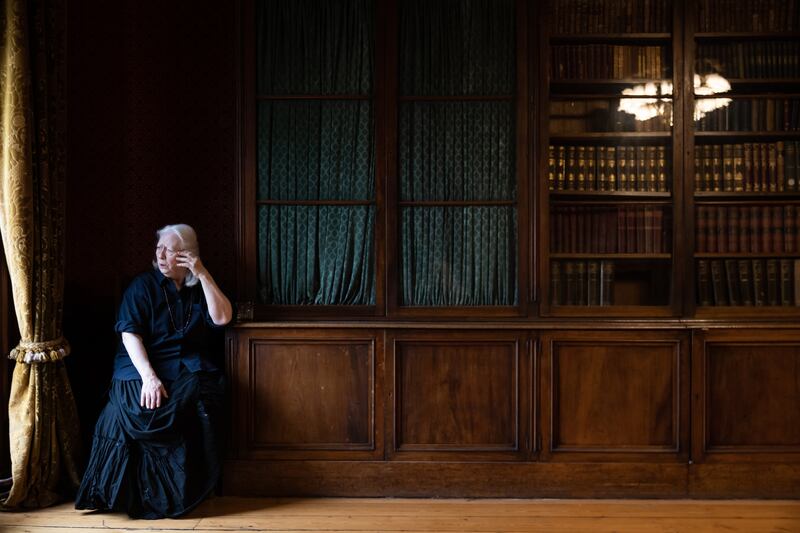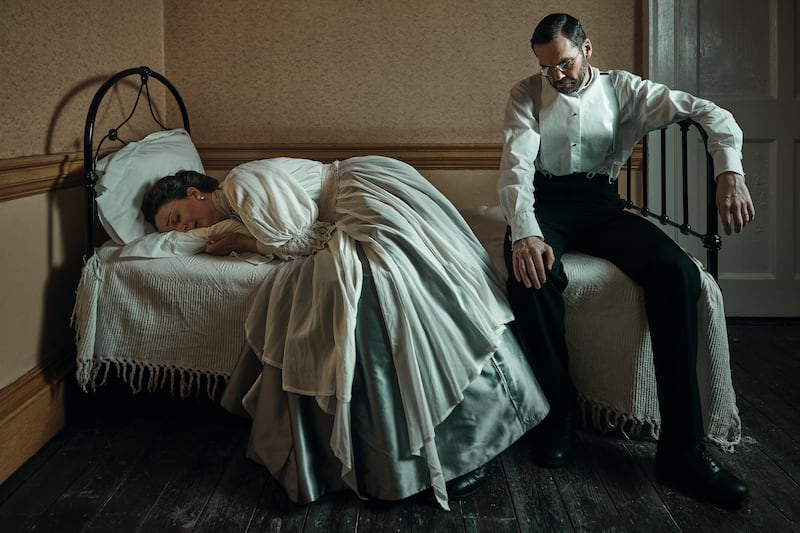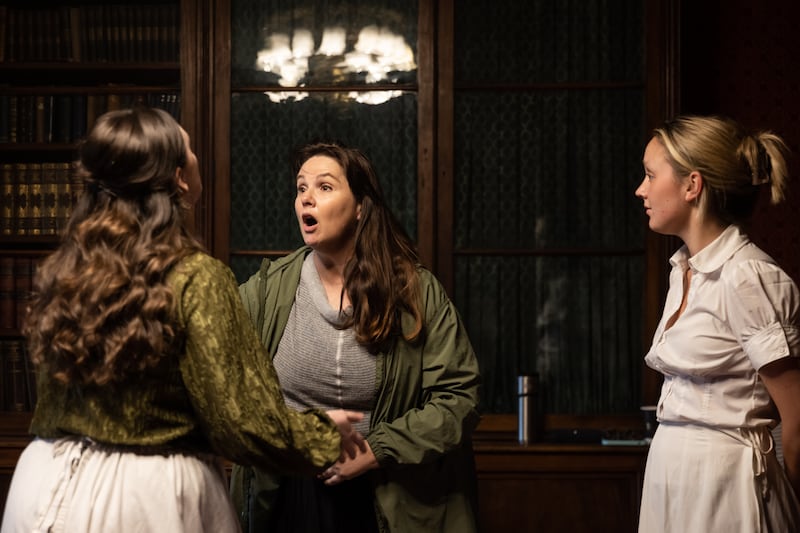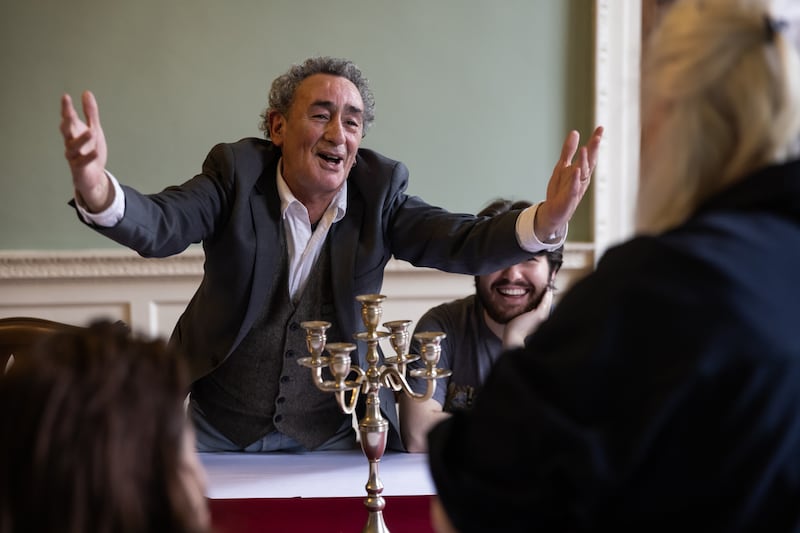This is deadly. Perfectly in sync with the season and perfectly in sync with the city. James Joyce’s 1907 short story The Dead, the last in his book Dubliners, set during a Christmas party in the house of the sisters Kate and Julia Morkan, is being brought to life as an immersive experience created by a crack team in a Georgian town house in the heart of Dublin.
Joyce set his story, an evocation of the past and mortality – and an epiphany on the Epiphany – at 15 Usher’s Island, the “dark gaunt” home of his great-aunts, now sadly in disrepair, and earmarked to become apartments. For this production it is taking over Newman House, on St Stephen’s Green, which is rather posher but from the same period, and a building Joyce attended when it was part of University College Dublin.
We open the door to the Bishop’s Room, on the first floor, a sea of busyness and action mid-rehearsal. There’s the very large cast – the women wearing boots and petticoats over their normal clothes for the bustle of movement – plus The Dead’s director, Louise Lowe, and designer, Owen Boss, both of the theatre company Anu, its producer Anne Clarke, of Landmark, Samantha Cade, its associate director, three stage managers and a photographer.
We’ve stumbled into the Christmastime drawingroom of Kate (who is played by Bairbre Ní Chaoimh) and Julia (Marie Mullen) and their niece Mary Jane (Roseanna Purcell) for their annual Twelfth-night dance with friends and family. They’re busy working out the timing and blocking of how Kate interrupts the “moment” that their nephew Gabriel Conroy and his wife, Gretta (who are played by Marty Rea and Maeve Fitzgerald), have by the fireplace. Hearing her call from outside works best; they play the interaction. “So many people”, Lowe says, grinning.
Alzheimer’s: ‘I’ve lost my friend and my companion,’ says Úna Crawford O’Brien of fellow Fair City actor Bryan Murray
Ryan Adams at Vicar Street: A gig that nobody will forget anytime soon, but perhaps not for all the right reasons
Meghan Markle’s new podcast: An ego-fluffing conversation underlining the culture gap between Ireland and the US
Then they rewind and the whole company run through a big block of the performance, including the drunken arrival of Freddie Malins (John Cronin); his mother, a sorrowful Mrs Malins (Billie Traynor), talking to Gabriel; a conversation about galoshes; dancing The Lancers; the aunts fussing; and the key moment when Molly Ivors (Úna Kavanagh) picks a row with Gabriel, calling him a bounder and a West Briton. During this key set-to the actors dance in slow motion, highlighting the interaction, like colour picked out against a fading black-and-white background.

We’re in the thick of this party when Aunt Kate swoops over and draws this interloper into conversation with the tenor Bartell Darcy (Oliver Flitcroft). Stories and chat and mingling ebb and flow, with songs and dance, much happening all at once, in the way of parties.
Then a switch: the double doors open to reveal the diningroom next door, which is dominated by an enormous table, the Misses Morkan turned in welcome. We’re ushered into seats at the table, alongside the cast, and into conversation. There’s teasing, banter, chat, a toast, clatter and chatter, Gabriel’s speech.
To sit amid this, to be part of it, is exhilarating and moving. It’s like inhabiting a sophisticated pop-up book of The Dead, the texture and nuance of multiple characters within touching distance. Later Lowe mentions watching the maid Lily (Pattie Maguire) all the way through Gabriel’s speech; in a story hinged on his epiphany, “I’ve tried with the cast to find little micro-epiphanies. All of them are altered in some way after this night.”
Back in the diningroom the action is punctured as we – and Gretta at the open door – hear Bartell Darcy singing The Lass of Aughrim up through the stairwell. It brings a catch to the throat.
The run-through finished, Maeve Fitzgerald sits beside me. She recalls the first read-through of the script, how it felt as if it was going to be an amazing production, and how “you kind of lose sight of this as you rehearse, so when fresh eyes come in ... ”
They’re only two weeks into rehearsals and already, judging by the 37-minute section they’ve just performed – about half of the production – The Dead looks to be in terrific shape. “We’ve never pushed all those bits together, and they’re only learning the dance,” Lowe says. “This is the longest section, that has everyone’s hearts,” from the narrative, “so you have to get all the little beats in.”
It’s fascinating to see an immersive show at this juncture, just as they’re stitching together sections they’ve worked on, and the actors themselves are seeing for the first time its shape and feel.
This is a coproduction between two long-established Irish theatre companies, Anu, who have nailed immersive live experience, and Landmark Productions, in association with Museum of Literature Ireland, which now occupies Newman House; the three have form together, having worked on Ulysses 2.2 productions to mark the centenary of Joyce’s novel.
At some stage years ago they realised the perfection of these rooms for an immersive version of the short story.
The Dead’s party scenes will take place in rooms that were Joyce’s world while he was a university student here. (He graduated in 1902.) The “university question” that archbishops discussed in this room at the time is part of Gabriel Conroy and Molly Ivors’s fictional conversation at the party. (Joyce modelled Ivors on the suffragette and nationalist Hanna Sheehy, who later married his friend Francis Skeffington.)
At the top of the house, what is still known as the James Joyce Classroom, from the writer’s college days, will become for this production the Gresham hotel bedroom where Gretta shares with Gabriel memories of her first, tragic love, Michael Furey, triggered by hearing The Lass of Aughrim, which was the song he sang her.
For this intimate production small audiences will move with and around the actors in these historic rooms, being greeted by Lily the maid (“literally run off her feet”), up the opulent staircase, past the Old Physics Theatre – where the student Joyce gave a lecture on Ibsen to the university’s Literary & Historical Society – and through secret stairwells and hidden doors into the dance.
At dinner, some of the audience will sit at the table with the remnants of dessert, others standing or sitting nearby. Audiences will be enveloped in the party but without obligation to respond or participate.

Later, Clarke, Lowe and Boss lead the way further upstairs to the Joyce classroom, through what feels architecturally like a different building; this short journey will allow a transition to the Gresham; the landing will become a hotel corridor. “That’s where it all changes now, and we’re in a different world,” Lowe says.
After the dinner in the flock-wallpapered Bishop’s Room the audience splits, and witnesses different scenes, but everyone will experience the bedroom scene. The room is not dressed yet; chairs and desks have been pushed aside to make space for the rehearsal four-poster bed. They used this room during Ulysses 2.2. It has, says Clarke, a special atmosphere. “You walk in and ... talk about ghosts!” she exclaims. “You really feel it.”
“We want the bedroom to feel much more intimate” after the action and interaction of the party, Lowe says. “We’ve had such a thrill and such fun getting to now, and then the bedroom changes everything. It’s easy to imagine ourselves as guests at the party. Here we have to change it, to become more like voyeurs.”
She talks about how the audience becomes the “shades of the dead” for Gabriel for that scene; “we realise we are all the shades of the dead,” she says, “all approaching our own mortality.”
Across the landing is the costume room. Racks of finery: hats, fabulous frocks, elegant suits, lace and embroidery, beads – gear for a party in the early years of the 20th century. Joan O’Clery, The Dead’s costume designer, shows us a large screen with detailed drawings of the outfits. Molly’s dress is green, Gretta’s an iridescent blue, evoking the Atlantic.
O’Clery is holding Molly’s beaded-lace chest inset. “When the audience comes in, it’s Christmassy. The fabrics we’ve chosen have a little bit of sparkle.” There are several coats, too, and hats. Gretta’s is velvet, with a blue feather; Gabriel has a fine wool coat and top hat. “He’ll be quite the figure coming in the door.”
With the entire cast on and up close all the time, every costume must be perfect, right down to the men’s bow ties, which they must knot themselves. “You can’t cheat that,” O’Clery says.
They can hear the music up here during rehearsals. “This is a dream costume job. Everyone dressed for a party and beautiful fabrics.”

The production’s stage manager, Leanna Cuttle, and her assistants, Oliver Kampman and Gillian Weston, will also be in costume, as Aunt Kate’s music students – not cast members but integral to how the show operates: they’ll be managing transitions and helping to shape the audience’s experience.
The costumes are lush, the cast is large, many are involved in the creation: this is a big-budget production, but it will be performed for only 75 people at a time. Even on days with three presentations, the total daily capacity is only a couple of hundred, which helps to put the €65 ticket price (concessions are €30) in context.
Lowe is “trying to create worlds where it doesn’t matter where you are in the room, because you won’t see everything absolutely”. There’s a lot going on, “and when we need to draw your attention we’ll be able to pull it in or out”.
Also, “it’s not Downton. It’s an Irish-family-ghost-story Christmas. The guests are really familiar with each other,” so it shouldn’t be too formal. She’s also “thinking about the social order, and what’s ahead and what’s behind them, nationally. It’s set on the cusp of change from an old order, pre-independence.” Ivors is “already militant”.
“Joan wants to push the costumes from 1904 and towards the 1910s,” Lowe says. “Then we can see it coming towards the [Dublin] Lockout [of 1913] and all that’s ahead of us.” Though not explicit, there’s a sense in conversations of trying to hold on to the past, and “a tension between the old and the new inside the story”.
[ From the archive: The Lockout of 1913 by President Michael D HigginsOpens in new window ]
Lowe has adapted Joyce’s story for performance, faithful to its narrative, characters, conversations, music and epiphany but fleshing out detail and dialogue to make it into theatre. She emphasises that “everyone is part of the dramaturgy”. Early on she asked them all what one element they would be loath to miss in it. She pulls out a page of Post-its noting incidents, from “Freddie and Mrs Malins sitting in silence” to “upmanship at the table” to Lily’s comment about “men is only all palaver”. She reworked her script with these in mind.
O’Clery suggested that the maid should bring in Molly Ivors’s coat and hat when she was leaving after their set-to: in the run-through earlier, that detail worked to emphasise her departure. “It’s an example where everyone’s involved in shaping it. It’s like a jigsaw. The source of a whole scene could come from the lights, or a moment,” Lowe says. “We are all making the show.”
Joyce’s story “lets us into his mind and what Gabriel is feeling, and theatre doesn’t really allow you the chance to do that, to sit with those micro-beats. Someone like Marty is well able to show us those minute transition points, especially where you see it play out in real time in the bedroom, which is extraordinary to watch”, and in sequences such as Gabriel’s speech after dinner, when he looks at Gretta to let her know he’s going to say something.
“He’s been rattled by events. The first that rattles him is with Lily at the very beginning, where she answers back about men being all palaver. She’s not just the maid. She’s got much more going on.”

Part of what Lowe is doing is not changing the story but making the women, the “disquietness” of those engagements, more prominent. “We’ve picked out four or five moments with women that make him look at himself differently.” Another is after Aunt Julia’s song. “There’s a great description of her walking backwards out of the room and him noticing it”, as she starts to lose herself, “almost eroding in front of us”, as a precursor to Gabriel’s later realisation that she will die soon. “Let’s hold that moment. And no one better than Marie Mullen to hold that moment.”
They’re about to gather again for rehearsals. Working at the dining table, Ciarán Bagnall, the lighting designer, describes his approach to The Dead as “being respectful to the space, to the cast, the detail and design and the aesthetic and the kind of the feeling we try to provide. It’s not about illumination necessarily. It’s about providing atmosphere for the space, delicately. There’s no ego to our work. It’s all about respecting the story.”
We talk corsets. They confine, altering how you sit or dance. Weston, the assistant stage manager, who is also a dresser, is trying hers on, to get used to it. Traynor, who plays Mrs Malins, recalls whalebone corsets in past shows. “They were excruciating. You couldn’t bend or lean back. No movement in them whatsoever.” These ones are a stretchy mesh, still with bones but allowing more movement. They’re “comparatively lovely”, she says.
One of The Dead’s most famous lines comes at its close, when, up in the Conroys’ Gresham bedroom, Gabriel contemplates how “snow was general all over Ireland”.
And will it be?
“There is a plan for snow,” Anne Clarke says, cryptically.
Anu and Landmark Productions in association with MoLI present James Joyce’s The Dead at 85 St Stephen’s Green, Dublin, from Tuesday, November 26th, until Sunday, January 12th, 2025, with previews from Friday, November 22nd




















